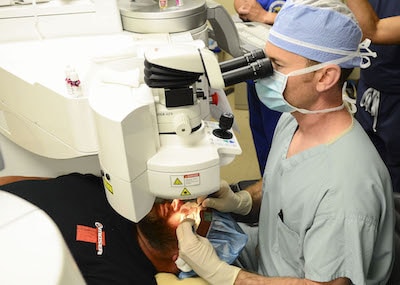Military Medical News: Wednesday, May 31, 2017
Published by on June 13, 2017
NMCSD BREAKS NEW GROUND FOR MILITARY MEDICINE WITH NEW VISION CORRECTION PROCEDURE
SAN DIEGO (April 24, 2017) Cmdr. John Cason, program director at Navy Refractive Surgery Center, performs a Kamra corneal inlay procedure for the treatment of presbyopia at the Naval Training Center Medical Branch Clinic.
The KAMRA corneal inlay is a mini-ring with an opening in the center that sits in the first few layers of the eye known as the cornea, focusing light coming into the eye restoring near vision. This is the first procedure of this kind done within the Department of Defense. (U.S. Navy Photo by Mass Communication Specialist 2nd Class William Cousins/Released)
SAN DIEGO – The Refractive Surgery Center aboard Naval Training Center (NTC), an outlying clinic of Naval Medical Center San Diego (NMCSD), successfully performed the first ever KAMRA Inlay surgery in the Department of Defense (DoD) April 24.
The Refractive Surgery Center specializes in optical surgery using lasers to correct vision, typically done through photorefractive keratectomy (PRK) and laser-assisted in situ keratomileusis (LASIK) in the history of the center. KAMRA Inlay is a corrective surgery that treats presbyopia, a common condition that makes it difficult for individuals to see close to them. Presbyopia affects everyone, eventually, to different degrees. KAMRA Inlay is a long lasting technology, treating one eye for near sightedness, while maintaining distance vision in both eyes.

“This is a treatment for our more senior servicemen and women, and it will be able to meet all their vision demands. They’ll be able to see distance, be able to see up close,” said Cmdr. John Cason, Program Director for Naval Refractive Surgery Center, NMCSD. “It is available to any active duty military, and while we gain experience with new technology, we are also offering it to dependents.”
This new technology offers total correction to vision deficiencies and is still eligible to servicemen and women who may have already received LASIK or PRK in the past.
“I am excited that it will correct my eye to match my other eye. I’m excited to not wear reading glasses and make day-to-day life easier,” said Petty Officer 1st Class Russell Staley, the first DoD KAMRA Inlay surgery patient.
Following the successful treatment, Staley will have over-corrected vision in both eyes that will give him vision better than 20/20, and completely eliminate any need for corrective lenses.

Lance Kugler, MD, is a specialist in LASIK and vision correction surgery and CEO of Kugler Vision. A proud Omaha native, he is passionate about improving lives through clear vision. Dr. Kugler serves on several national boards, and his practice is recognized internationally as a center of excellence. Dr. Kugler is one of the original founders of the Refractive Surgery Alliance, an international organization comprised of over 350 of the world’s leading vision correction surgeons; he also served as its first president. In 2019, Dr. Kugler was selected as a TEDx speaker, and delivered a talk in Omaha about the worldwide epidemic of nearsightedness and refractive solutions. Dr. Kugler is an Associate Professor of Refractive Surgery at the University of Nebraska Medical Center’s Truhlsen Eye Institute, has been published in many medical journals, and participates in numerous clinical studies to advance the field of vision correction surgery. Additionally, Dr. Kugler is proud to be a Board Certified Fellow of the World College of Refractive Surgery & Visual Sciences. Dr. Kugler and his wife are proud parents to five active kids. When he has a spare moment, he enjoys skiing, tennis, travel, and fine coffee.




Leave a Reply